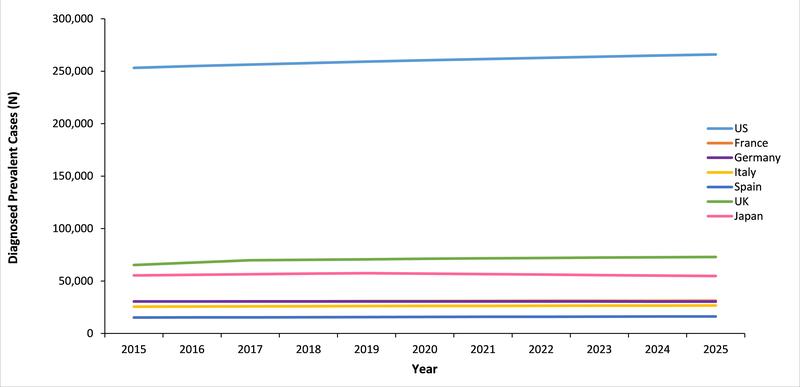

Systemic lupus erythematosus (SLE) is an autoimmune disease where the immune system attacks its own healthy body tissues. SLE is a poorly understood condition that can have both short and long term impacts on a person’s quality of life.
GlobalData epidemiologists forecast an increase in diagnosed prevalent cases in the seven major markets (7MM) of the US, France, Germany, Italy, Spain, the UK, and Japan, from 475,698 in 2015 to 498,420 in 2025 at an annual growth rate (AGR) of 0.48% (Figure 1). SLE is chronic and relapsing. Patients can experience long periods with few symptoms before having a sudden and severe flare-up of symptoms. Due to the projected increase in diagnosed prevalent cases and the relapsing nature of SLE, there is a call for greater public awareness of the disease in order to achieve early diagnosis.
Among the 7MM, the UK has the highest rate of diagnosed prevalence of SLE (0.10%) followed by the US (0.08%). Spain had the lowest prevalence of SLE (0.03%). GlobalData epidemiologists estimated that in 2015, the US contributed 53% of all diagnosed prevalent cases of SLE in the 7MM. Of the 7MM, only the US and the UK will see an increase in diagnosed prevalence of SLE. GlobalData epidemiologists forecast an increase in diagnosed prevalent cases of SLE in the US, from 253,215 cases in 2015 to 265,953 case in 2025, at an AGR of 0.50%.
GlobalData epidemiologists attribute the increase in diagnosed prevalent cases to changes in the population and an increase in the diagnosed prevalence of SLE. The UK is also expected to see an increase in diagnosed prevalent cases, from 65,331 in 2015 to 73,099 case in 2025 (Figure 1). The UK’s share of all diagnosed prevalent cases of SLE in the 7MM is also expected to increase from 14% to 15%. This increase in cases will be driven by an increase in diagnosed prevalence and changes in the population.
Currently, there is no cure for SLE, but there are different medications that can help relieve the symptoms and organ damage caused by the disease. Early diagnosis and effective treatment are important in reducing the detrimental effects of SLE and improving the quality of life of those who suffer from the disease. In the future, it will be important to increase early diagnosis, especially among women, as they are up to six times more likely to be diagnosed with SLE than men.
How well do you really know your competitors?
Access the most comprehensive Company Profiles on the market, powered by GlobalData. Save hours of research. Gain competitive edge.

Thank you!
Your download email will arrive shortly
Not ready to buy yet? Download a free sample
We are confident about the unique quality of our Company Profiles. However, we want you to make the most beneficial decision for your business, so we offer a free sample that you can download by submitting the below form
By GlobalDataAlthough public awareness will be important, the public health agenda for lupus will also need to focus on a better case definition for the disease, since making a diagnosis can be challenging due to the varied symptoms and lack of a specific test for diagnosis. The figure below highlights the projected increase in diagnosed prevalent cases of SLE in the US, France, Germany, Italy, Spain, the UK, and Japan from 2015 to 2025.







